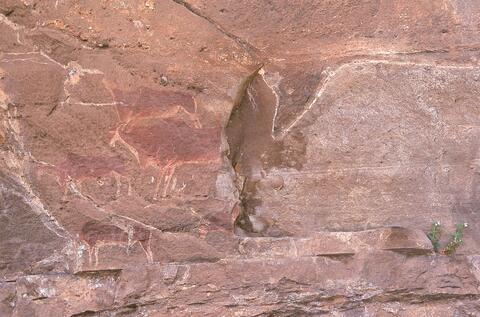Identificatie
referentie code
Titel
Datum(s)
- 15/11/2000 (Vervaardig)
Beschrijvingsniveau
Omvang en medium
Context
Naam van de archiefvormer
Biografie
Brief description of site: RSA HAE1 is situated in a SE facing, high and quite deep 30.1 m long rock-shelter in a kom or vale just before the Bonnyvale homestead. There is a rock tumble in the western and deeper part of the shelter. The floor is level as a result of stabilising and a retaining wall built by Mr. Istead. There are also furrows to lead rainwater away and trees planted below the retaining wall. The site is secluded.
There appears to be some depth of archaeological deposit - up to 75 cm in places, though the integrity of the deposit is uncertain as a result of possible disturbance from the stabilising of the deposit. There are dry patches as well as areas that are seasonally inundated. There are a few visible surface scatters of lithics on both opalines (crypto-crystalline silicates) and hornfels (indurated shale) rocks. There are chips, chunks and cores; all of which suggest that this shelter was used as a home by the San in times past. There are also numerous finished lithics in the form of endscrapers - used to work leather; adzes - used to work wood; and flakes - used as general purpose cutting tools. No bone, charcoal, ostrich eggshell or leather remains were noted. There are remnant sections of stone walls - probably from herders - in the shelter.
Brief description of art: Trance dance.
There are in excess of 450 individual San rock-paintings in the shelter, that show it not only to be a practical living shelter, but also a locus of great spiritual importance to the San. The paintings are too numerous to discuss individually and I highlight certain image clusters:
Medicine Dance: Halstone has a particularly good example of a Medicine or Trance Dance in which over a dozen human figures, painted in red, black and white, are shown in a variety of dance postures and activities. For example, one figure points; other figures are seated and clapping, others are standing and hold their arms behind their backs and above the heads while still others bend forward with constricted waists and hold dancing sticks. At least three of the dancers bleed from the nose and one even has an antelope head. This entire dance cluster is surrounded by tiny white flecks.
Animal images: There are over 60 eland (Tragelaphus oryx) shown; some in beautiful shaded polychrome. There is also a very rare depiction of a warthog (Phacochoerus aethiopicus) or bushpig (Potamochoerus porcus) in black with white tusks. To top it all, this bushpig/warthog is shown with what appear to be four babies, one suckling. There are also a number of animals not identifiable to genus or species, but vaguely alcelaphine-like. There are 3 felines in bright yellow and white paint as well as baboons painted in black; recognisable by their crooked black tails. There are also numerous Mountain rhebuck (Redunca fulvorofula) painted in red, white and black with great attention to detail. In one instance there is a rhebuck herd of over 25 individuals painted running, walking, lying down and so forth. Interestingly, in this herd of white rhebuck, there is only one with a red head. There is also a depiction of what may be a wildebeest.
Human figures and enigmas: There are at least 80 human figures depicted throughout the shelter is a variety of colours, sizes and postures. There is, for example, an unusual white human figure with large buttocks and red body decoration. Several human figures have animal attributes such as antelope heads and hooves. There is also a 'flying buck' painted - an kneeling part-human, part-animal creature with swept back arms or wings. High up in the central part of the shelter is a thick undulating serpentine-like line from which animal and human heads emerge as well as thin red lines. Some of the human figures are depicted carrying spears and possibly shields. There are enigmatic areas where red and light red pigment has been smeared, forming no discernible image. There is a frieze of 8+ human figures in the eastern end of the shelter, one of which draws a bow. These human figures have fine, white body decoration and ornaments.
Naam van de archiefvormer
Biografie
Nationality: South African
Created by: willem
Created on: 11/03/2003
Naam van de archiefvormer
Biografie
archiefbewaarplaats
Geschiedenis van het archief
Directe bron van verwerving of overbrenging
Inhoud en structuur
Bereik en inhoud
The eland was the first animal that the San trickster deity, /Kaggen created and it remained his favourite.
The eland is the largest of southern African antelope and is much desired for its meat and fat. The San say that all other animals are like servants to the eland.
The importance of this animal is shown in the great variety of postures and perspectives. It is depicted running with tail outstretched, with uplifted head smelling the wind, and upside down, presumably dead. The eland is also depicted from the front or from the back, and even from above.
The eland appears in four important San rituals it is the most carefully depicted antelope in both rock paintings and engravings: Trance dance, boy's first kill, girl's puberty and marriage. It is believed that eland fat contains a lot of potency and in a trance dance shamans aspire to possess eland potency.
Waardering, vernietiging en slectie
Aanvullingen
Ordeningstelsel
Voorwaarden voor toegang en gebruik
Voorwaarden voor raadpleging
Voorwaarden voor reproductie
Taal van het materiaal
- Engels
Schrift van het materiaal
Taal en schrift aantekeningen
Fysieke eigenschappen en technische eisen
Original size: 35mm

